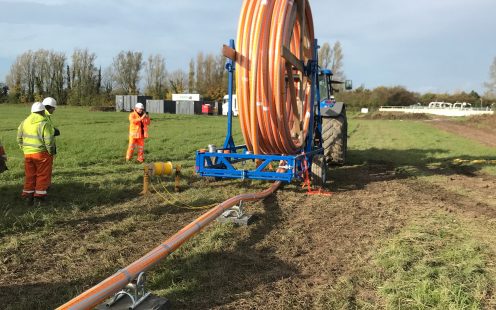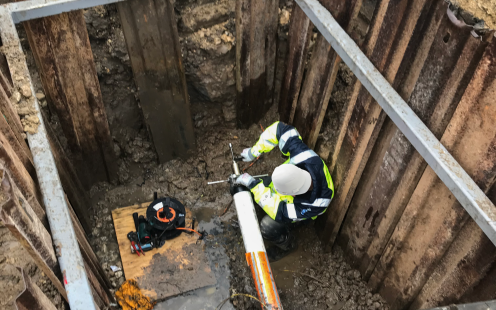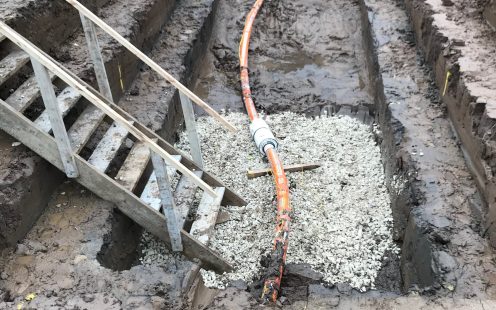.jpg)
Trenchless Installation Allows Recommissioning a Depleted Gas Field in the UK
Mar 18th, 2022 | 3 min read
The Saltfleetby Gas Field, located in East Lincolnshire, is one of the largest onshore gas fields in the United Kingdom. When a bypass of an old terminal was required to reconnect part of this field directly to the National Grid system, trenching was not an option due to the resulting environmental disruptions. Pipelife’s brand SoluForce proved to be a perfect solution to this challenging project.
Installing a New Line with Minimal Disturbance
To resume recovery from part of the Saltfleetby Gas Field, which had been shut down by the operator, a new connection to the gas grid was needed. However, installing a gas line was tricky, as it would have to cross a farm field. Since this environment could not be disturbed, conventional pipe installation was not possible. A trenchless solution was needed; furthermore, the new pipe had to be robust enough for high-pressure gas transportation and require minimal maintenance.
Installation of a new pipe by Horizontal Directional Drilling (HDD) was seen as the best option, as it allowed minimizing the footprint on the surrounding environment. The flexible composite pipe system by Pipelife’s brand SoluForce was selected due to favorable operational expenses and comparably low total cost of ownership. Only a small section was laid in an open trench, and the installation could be carried out quickly and with hardly any disturbance to the surrounding area and its infrastructure.
.jpg)
Reliable Pipelines for Lasting Gas Networks
In total, 440 meters of SoluForce Heavy Gas Tight pipe were installed to reconnect the field. SoluForce Gas Tight systems are made from plastic composites featuring a fully enveloped aluminum layer, making them completely impermeable to gases and eliminating possible health, safety and environmental risks. When run at operating parameters, maintenance is not required, and the expected service life of the system is at least 20 years.
According to the project requirements, the piping system would have to withstand up to 70 bar gas operating pressure and up to 54° C operating temperature. SoluForce Heavy Gas Tight pipes exceed these, as the gas pipe system’s maximum pressure is 156 bar and the maximum allowable operating temperature is 65° C.
Complete Solution for Challenging Installation
The pipe was custom-produced in orange color with silver stripes to meet the local regulations for high-pressure gas pipes. Preparations such as cutting the pipe to the necessary length were important to ensure there are no interruptions during the HDD process. SoluForce provided an uncoiling trailer for easy uncoiling of the pipe and electrofusion equipment for attaching the fittings.
HDD requires the pipe to be pulled through a borehole in the soil. The high flexibility of SoluForce reinforced pipes combined with their toughness is a perfect fit for such applications. The outer HDPE cover layer provides the required protection from mechanical forces, debris and rock while the pipe is being pulled through.
SoluForce electrofusion end fittings were attached at each end of the pipe. These fittings, just like the pipe itself, are metal-free, making them highly corrosion-resistant. No welding of metal surfaces was required to install the system, saving considerable time because welding permits were not required.
.jpg)
Achieving Optimal Recovery from Depleted Gas Fields
The UK is determined to reduce or offset carbon emissions to net-zero by 2050. However, the country’s oil and gas industry will play a crucial role in this transition to continue meeting the local energy needs of consumers while developing and implementing low-carbon technologies like carbon capture, use and storage (CCUS), and hydrogen.
Environmental concerns linked to the development of new gas fields, rising gas prices, and tight supply currently on the market highlight the importance of achieving optimal recovery from the country’s existing gas fields — including those previously considered unattractive.
Using flexible composite pipe systems for gas transportation considerably lowers OPEX and TCO compared to alternatives, making the recommissioning and recovery from marginal and depleted fields more attractive.
Get in Touch
Please choose your preferred way to get in contact with us. We will get back to you as soon as possible.
Callback